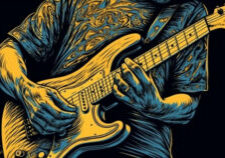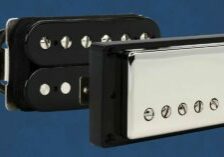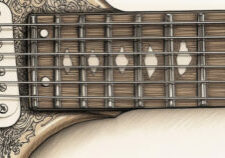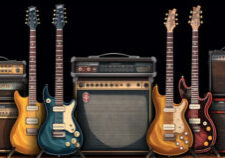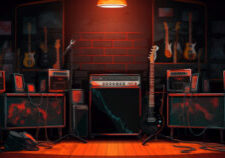The fretboard is the part of the guitar where the player presses down on the strings to create different notes and chords. There are several types of fretboards available for electric guitars. Maple, rosewood, and ebony are the most common. Each type of fretboard has its own unique characteristics that can affect the sound and playability of the guitar. Lets explore the differences between these three types of fretboards and how they can impact your playing experience.
Maple Fretboards: Pros and Cons
First up is the maple fretboard. Maple is a popular choice for guitar necks and fretboards due to its bright tone and durability. Maple fretboards are known for their clarity and sustain, making them an excellent choice for players who want a bright, punchy sound.
One of the main advantages of a maple fretboard is its smooth surface. The wood is hard and dense, which means that it resists wear and tear better than other types of wood. This makes it an ideal choice for players who like to play fast or use heavy gauge strings. Additionally, maple fretboards are easy to clean and maintain, which is a plus for players who want to keep their guitar looking new.
Another advantage of maple fretboards is their appearance. The light color of the wood provides a striking contrast against darker finishes on the guitar body are appealing to many guitarists.
There are also some downsides to using a maple fretboard. One potential issue is that the bright tone can be too harsh for some players’ tastes.
Also maple fretboards need to be finished and if finished in a thick layer of poly, they can fell sticky. This is generally something you see on a cheap imports. I have 5 different strats or similar guitars with maple fretboards with a light finish that is very comfortable.
But if you don’t like the smooth surface of the maple fretboard, you might find it difficult to play with precision, especially if they are used to playing on a more textured surface like rosewood or ebony.
They can be prone to developing small cracks over time, but generally this would only happen if you stored your guitar in a harsh environment. In other words, don’t leave it out in your shed in the cold winter and don’t store guitars in a hot attic!
The Beauty and Durability of Rosewood Fretboards
Rosewood is a dense and durable hardwood that is known for its rich, warm tone and beautiful grain patterns. It is often used on high-end guitars because of its beauty and durability.
One of the main benefits of a rosewood fretboard is its tonal qualities. Rosewood IS a tone wood. It has a warm, mellow tone that is well-suited for playing music that require a smooth, rich sound. The density of rosewood also helps to enhance sustain and resonance, which can make notes ring out longer and sound more full-bodied.
Another advantage of rosewood fretboards is their durability. Rosewood is a hard and dense wood that can withstand years of heavy use without showing signs of wear and tear. Rosewood does not need a finish. It is naturally oily wood. This makes it an ideal choice for players who want a guitar that will last for many years without needing frequent repairs or replacements.
The wood also has a unique aesthetic appeal. The grain patterns in rosewood can vary widely, from straight lines to swirling patterns that resemble waves or flames.
So what are the drawbacks?
One issue is that rosewood can be more difficult to maintain than other types of fretboards. Because it is a porous wood, it can absorb oils from your fingers over time, which can cause the wood to darken and lose its luster. To prevent this, it is important to clean and oil your rosewood fretboard regularly.
Another potential issue with rosewood fretboards is that they can be more expensive than other types of fretboards. Especially if you want a visually appealing piece. This is because rosewood is a high-quality hardwood that is in high demand among guitar makers and sometimes depending on the season, it can get expensive. Brazilian Rosewood can sometimes be very expensive. However, many players feel that the added cost is worth it for the superior tone and durability that a rosewood fretboard provides.
Ebony Fretboards: The Dark Horse of Electric Guitars
Ebony is a dense and durable wood that is known for its dark color and smooth texture.
One of the most significant advantages of ebony fretboards is their ability to produce a bright and clear tone. The dense nature of ebony wood allows for excellent sustain, which means that notes played on an ebony fretboard will ring out longer than those played on other types of fretboards. This makes ebony fretboards an excellent choice for lead guitarists who want their notes to stand out in a mix.
Another advantage of ebony fretboards is their smooth texture. Unlike other types of fretboards, such as maple, which can feel sticky, ebony has a silky-smooth feel that makes it easy to play fast and intricate passages. This makes ebony fretboards an excellent choice for shredders or anyone who wants to play with speed and precision.
In addition to their tonal and tactile advantages, ebony fretboards are also highly resistant to wear and tear. The dense nature of ebony wood means that it can withstand years of heavy playing without showing signs of wear or damage. This makes ebony fretboards an excellent choice for touring musicians or anyone who wants a guitar that will last for years without needing significant repairs or maintenance.
Despite their many advantages, ebony fretboards are not without their drawbacks One potential downside of ebony fretboards is their cost. Ebony is a rare and expensive wood, which means that guitars with ebony fretboards can be significantly more expensive than those with other types of fretboards.
Another potential drawback of ebony fretboards is their maintenance requirements. Because ebony is a dense and oily wood, it can be challenging to keep clean and free of dirt and grime. Players who use guitars with ebony fretboards will need to take extra care to keep them clean and well-maintained to ensure that they continue to produce the best possible tone.
Comparing the Tone of Maple, Rosewood, and Ebony Fretboards
When it comes to electric guitars, the fretboard is an essential component that can significantly impact the tone of the instrument.
- Maple fretboards are known for their bright and snappy tone. They produce a sharp attack and a clear, defined sound
- Rosewood fretboards, have a warmer and more mellow tone than maple. They produce a rich, full-bodied sound has great sustain.
- Ebony fretboards are known for their dark and articulate tone, but brighter than Rosewood. They produce a tight and focused sound, popular for heavy metal and hard rock.
But here is the deal. There are guitar players from every style of music that play guitars with every one of these 3 woods. The differences are subtle and often it comes down to feel.
My favorite is a maple, but I tend to prefer necks that have been worn down over the years or even maple necks with a very light coat of finish. If you want a maple feel with no finish, you can also get roasted maple as the process of roasting means the maple does not need to be finished.
Evolution of Fretboard Materials and Other Woods
The history of fretboard materials in electric guitars dates back to the early days of the instrument. In the 1950s and 1960s, most electric guitars were made with maple fretboards. This was partly due to the fact that maple was readily available and relatively inexpensive at the time. However, as guitar players began to experiment with different styles of music and playing techniques, they began to demand more from their instruments.
In response to this demand, guitar manufacturers began to experiment with different types of wood for their fretboards. Rosewood was one of the first woods to be used, and it quickly became popular among guitar players who were looking for a warmer, more mellow tone. Ebony soon followed, and it quickly became the preferred choice for many professional musicians. Both of these woods were popular in making other instruments so they were a natural choice.
Today, there are many different types of fretboard materials available for electric guitars. In addition to maple, rosewood, and ebony, there are also other woods such as mahogany, pau ferro, and even synthetic materials like carbon fiber. Each of these materials has its own unique characteristics and sound, and guitar players can choose the one that best suits their playing style and musical preferences.
Conclusion: Fretboard Woods
The choice is 100% up to the guitar player. If you are like me, you will probably end up with a guitar with each of these common woods. I would just suggest that you play higher end guitars when testing fretboards, especially maple. Really cheap guitars will put so much poly on maple necks that it feels like you are playing a piece of plastic. So, its best to go into a guitar store and play more expensive guitars. Just watch out, you might empty your wallet!

